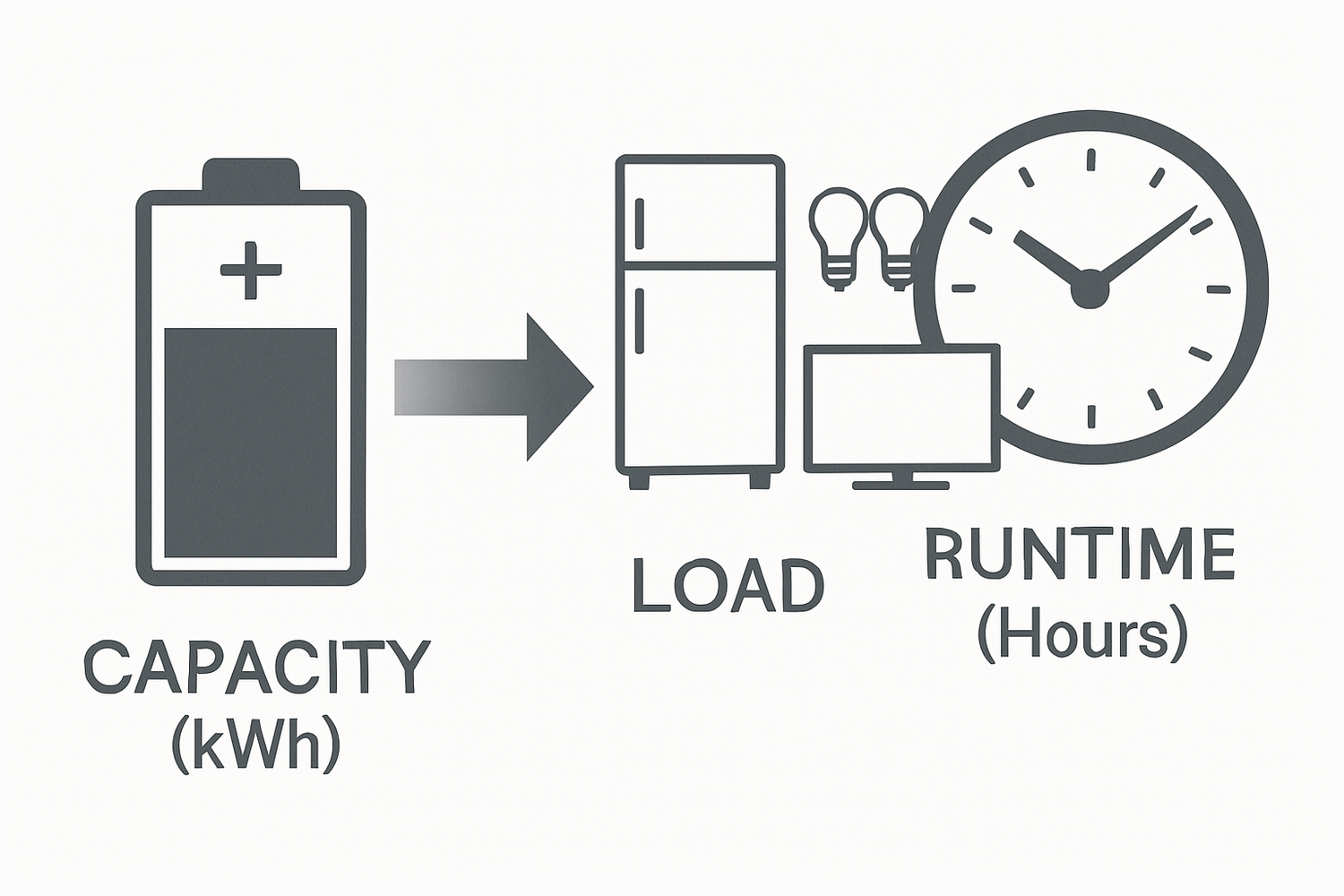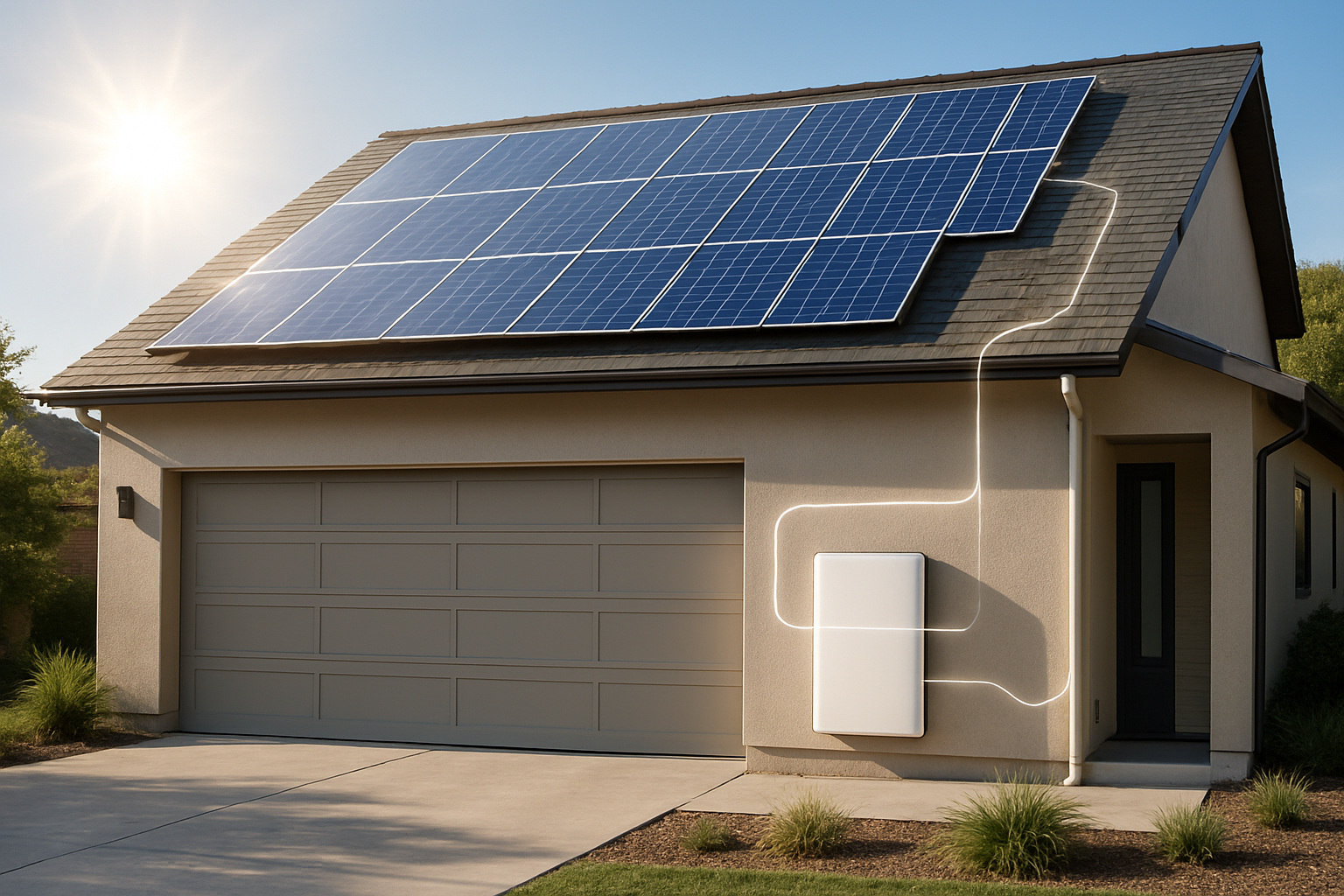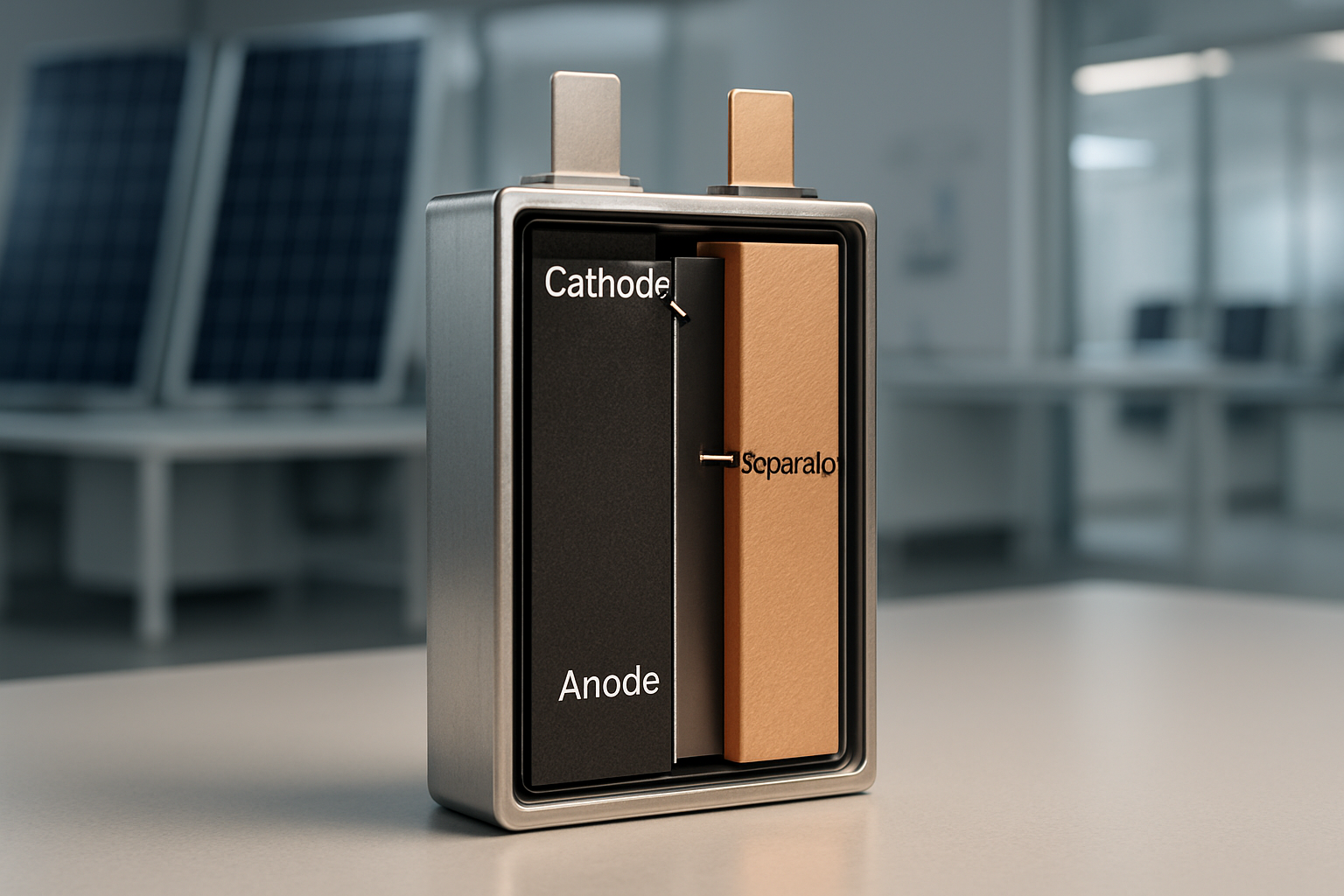When planning for an energy storage system, many people focus on a single number: battery capacity. It's easy to assume that a bigger battery automatically means you'll have power for a longer time. While capacity is a crucial piece of the puzzle, it doesn’t tell the whole story. The real goal for most users is achieving a specific runtime—the actual hours or days a battery can power their equipment.
Understanding the distinction between battery capacity (the size of your energy tank) and runtime (how long that energy lasts) is fundamental to designing a system that delivers reliable power when you need it most. This knowledge is the first step toward true energy independence.
The Fundamentals: Defining Battery Capacity and Runtime
To properly plan your energy system, you first need to grasp the two core concepts. They are related, but they measure different things.
What Is Battery Capacity?
Battery capacity is the total amount of energy a battery can store. Think of it as the size of a fuel tank in a car. This is typically measured in two ways:
- Amp-hours (Ah): This unit tells you how many amps a battery can deliver over a certain number of hours. For example, a 100Ah battery can theoretically provide 1 amp of current for 100 hours.
- Kilowatt-hours (kWh): This is a more direct measure of total energy. It represents the ability to deliver one kilowatt of power for one hour. kWh is often more useful for sizing home energy storage systems because your electricity bill is measured in kWh.
Modern solutions often use high-performance Lithium Iron Phosphate (LiFePO4) batteries, known for their ability to store significant energy in a safe and reliable package.
What Is Runtime?
Runtime is the duration a battery can power a specific set of devices, known as the "load." Unlike capacity, which is a fixed value, runtime is highly variable. It depends entirely on how much power you are drawing from the battery at any given moment.
Returning to the fuel tank analogy, runtime is how many miles you can drive. It depends on your speed, the terrain, and the efficiency of your car. A large tank doesn't guarantee a long trip if you're driving uphill with the accelerator floored.
The Core Relationship: Why Capacity Doesn't Equal Runtime
The central point is this: a high-capacity battery can have a very short runtime if it's connected to a large load. Conversely, even a small-capacity battery can provide a long runtime for a very small load. The key is understanding your consumption. Effective load planning is the bridge between the battery capacity you purchase and the runtime you actually achieve. For a deeper look at this process, consider reviewing a Stop Guessing: A Blueprint for Sizing Your Energy Storage.
Key Factors That Influence Actual Battery Runtime
Your battery's datasheet provides its capacity, but the real-world runtime you get is influenced by several dynamic factors. Accounting for these is essential for accurate system design.
The Impact of Your Energy Consumption (Load)
The single biggest factor determining runtime is your electrical load—the combined power consumption of all the devices you are running. High-power appliances like air conditioners or water heaters will drain a battery much faster than low-power devices like LED lights or a laptop charger.
To plan effectively, you need to know what you intend to power. Here is a table of common appliances and their typical power draw:
| Appliance | Average Power Consumption (Watts) |
|---|---|
| LED Light Bulb | 10W |
| Laptop Charger | 65W |
| Refrigerator | 150-200W (when running) |
| Television (50" LED) | 100W |
| Microwave Oven | 1,000W |
| Central Air Conditioner | 3,500W |
Note: These are estimates. Always check the labels on your specific appliances for accurate figures.
A detailed calculation of your energy needs is the first step. You can learn more about this in our guide on How to Calculate Runtime for Your Home Energy Storage System.
Depth of Discharge (DoD)
Depth of Discharge (DoD) refers to the percentage of the battery's total capacity that is used. To extend a battery's lifespan, it is not recommended to drain it completely to 0%. For example, if you only use 80% of a 10kWh battery, your usable capacity is 8kWh.
This is where technology choice matters. LiFePO4 batteries have a significant advantage, as they can safely handle a high DoD, often 90% or more, without significant degradation. This means you get to use more of the capacity you paid for compared to older battery chemistries. To better utilize your battery's potential, see how LiFePO4 DoD Explained: Unlock More Power From Your Battery.
System Inefficiencies and External Conditions
No energy system is 100% efficient. Some energy is always lost during the conversion and transfer process.
- Inverter Efficiency: A solar inverter converts the battery's DC power to AC power for your home. This process typically involves an energy loss of 5-10%.
- Temperature: Extreme cold or heat can temporarily reduce a battery's effective capacity and overall performance.
- Battery Age: Over time and with many cycles, all batteries gradually lose some of their original capacity.
These elements collectively impact how much runtime you can expect. For a complete overview, explore the 7 Key Factors That Determine Your LiFePO4 Battery Runtime.
Sizing Your System: From Theory to Practical Application
With a clear understanding of capacity, runtime, and the factors that connect them, you can now approach battery sizing with confidence.
A Step-by-Step Approach to Battery Sizing
Proper battery sizing ensures your system meets your needs without overspending on unnecessary capacity.
- Conduct a Load Audit: List every appliance you want to power. Record its wattage and estimate how many hours per day you will use it. This gives you your total daily energy consumption in watt-hours or kWh.
- Determine Days of Autonomy: Decide how many days you want your system to run without any recharging from solar or the grid. For critical loads, having at least one to two days of autonomy is a common practice. The International Renewable Energy Agency (IRENA) notes that system autonomy is a key design consideration for ensuring reliability, particularly in off-grid applications.
- Factor in DoD and Efficiency: Adjust your calculation to account for the usable capacity (DoD) and system losses.
A simplified formula to estimate your needs is:
Required Capacity (kWh) = (Daily Energy Use in kWh × Days of Autonomy) / (DoD × System Efficiency)
This calculation helps answer the question: Solar Battery Sizing: Is Bigger Capacity Always Worth It?
The Role of Solar and Integrated Systems
For an off-grid or hybrid setup, solar panels are the engine that recharges your batteries. The size of your solar array directly impacts how quickly your batteries can be replenished, effectively extending your runtime indefinitely during sunny weather. The International Energy Agency (IEA) reports that the deployment of battery storage is growing rapidly, driven by the need to support variable renewable sources like solar.
Modern home energy storage systems integrate LiFePO4 batteries, a hybrid solar inverter, and intelligent management software into a single unit. This approach streamlines installation and optimizes energy flow between your solar panels, battery, home, and the grid, ensuring you get the most out of your stored energy.
Beyond the Basics: Advanced Considerations
For those looking to optimize their system further, a few more concepts are helpful.
Scalability and Future-Proofing Your System
Your energy needs may change over time. You might add new rooms to your home or purchase an electric vehicle. Choosing a modular energy storage solution allows you to start with a capacity that meets your current needs and easily add more batteries later. This scalability is a core feature of well-designed systems, providing a path for future growth without replacing the entire setup.
As the U.S. Department of Energy's *Solar Futures Study* highlights, the expansion of solar energy will require vast amounts of energy storage to help stabilize the grid. A scalable home system positions you to be part of that future. This practical approach is covered in the Battery Capacity vs. Runtime in Home Energy Storage: A Practical Guide for Homeowners.
Making an Informed Decision for Your Energy Future
The relationship between battery capacity and runtime is clear: capacity is a fixed potential, while runtime is the variable result of how you use that potential. By carefully planning your loads and understanding the key factors like DoD and system efficiency, you can accurately size a battery system that delivers the performance you expect.
Designing a reliable and scalable energy solution is the most direct path to achieving greater energy independence. By moving beyond simple capacity ratings and focusing on your desired runtime, you can build a system that serves you effectively for years to come. For a comprehensive look at what to expect, check out The Ultimate Guide to Residential Energy Storage Runtime.
Disclaimer: The information provided here is for educational purposes only. It is not financial or legal advice. You should consult with a qualified professional before making any decisions regarding the design or installation of an energy system.





Leave a comment
All comments are moderated before being published.
This site is protected by hCaptcha and the hCaptcha Privacy Policy and Terms of Service apply.